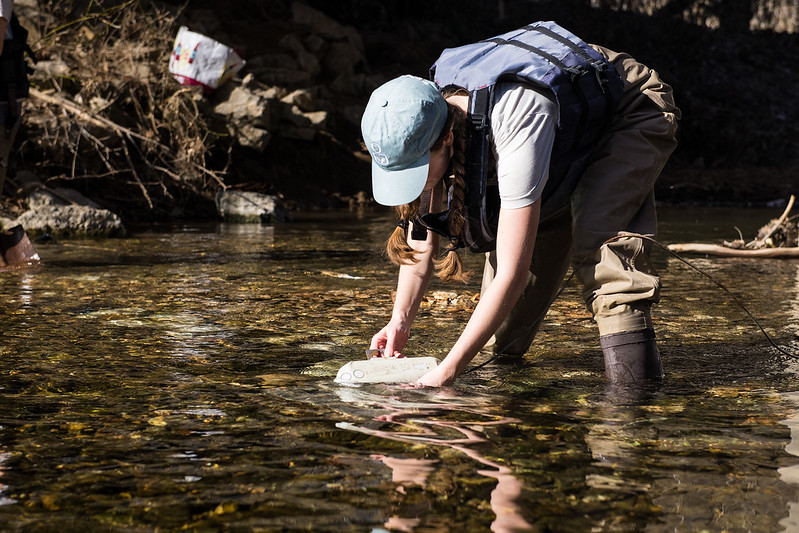Jan. 20, 2023
Researchers pursue cost-effective method to remotely monitor streamflow in small-scale watersheds
By Fred Miller
U of A System Division of Agriculture
@AgNews479
Fast facts
- Streamflow data essential for state and federal agencies and researchers
- Existing technologies are expensive, designed for large-scale watersheds
- Researchers evaluate low-cost system for smaller-scale watersheds
(624 words)
Related PHOTOS: https://flic.kr/s/aHBqjAo28t
Related research paper: https://elibrary.asabe.org/abstract.asp?aid=53103
FAYETTEVILLE, Ark. — Researchers at the Arkansas Agricultural Experiment Station have developed an economical method to monitor rainwater surges in small streams.
They showed that compact upward-scanning doppler radar systems designed to monitor manmade waterways can be adapted to monitor streamflows in natural channels of smaller watersheds.
Long-term streamflow data is essential to understand changes in hydrology and trends in natural disturbances like floods and drought, said Brian Haggard, professor of biological and agricultural engineering for the experiment station, the research arm of the University of Arkansas System Division of Agriculture.
Haggard is director of the experiment station’s Arkansas Water Resources Center. He also has a teaching appointment with the University of Arkansas’ College of Engineering.
Fresh water is a small percentage of the Earth’s water supply, but it is vital for human wellbeing, ecosystem support, economic activity and other purposes, Haggard said. Human activity and natural changes have great influence on available freshwater sources. Monitoring streamflow under extreme conditions caused by drought or stormwater runoff is essential for understanding how these stresses affect freshwater ecosystems.
Streamflow data support municipalities that need to manage storm surge water, Haggard said. State and federal agencies and researchers need the information to build and validate watershed models for the movement of sediments and nutrients and to find and correct nonpoint pollution sources.
Haggard said that most techniques for measuring and recording streamflow data can be costly to install and maintain.
“Installing and operating a typical streamflow monitoring station represents an investment of about $50,000 for the first year and around $25,000 for each subsequent year,” he said.
The instruments are not designed to be portable and are not easily moved to multiple locations, Haggard said.
A three-year study by Abbie Lasater, one of Haggard’s former graduate students, evaluated a low-cost method for remotely monitoring streamflow in small-scale watersheds. Haggard said these are mostly smaller streams that feed into larger watersheds, such as the White River.
Lasater led the study in the upper Poteau River Watershed in western Arkansas and eastern Oklahoma. The U.S. Environmental Protection Agency supported the study with a $415,415 grant administered through the Arkansas Natural Resources Commission.
Lasater used three SonTek-IQ acoustic doppler instruments, rotating them to 12 research sites to monitor streamflow discharges in the upper watershed, Haggard said. Cables connected the units to battery packs and data ports mounted above the high-water levels of each stream. The team used inexpensive pressure transducers to measure stream depth continuously.
The researchers collected stream depth continuously at each location and storm surge data following rain events, Haggard said. The compact SonTek units provided effective and accurate measurements in the small stream settings.
Haggard said the SonTek devices are designed for measuring flow through manufactured waterways like stormwater conveyances and irrigation canals where the shape and volume of the channels are known. Central to this research was to see if they could accurately measure flow through the irregular channels of natural streams.
The research team learned some valuable lessons about using the compact devices, Haggard said. For example, it’s essential to anchor the devices securely. One unit was lost when a storm surge overpowered the concrete pad used to hold it in the streambed. Brad Austin, a research scientist for the Arkansas Water Resources Center, said they now use a steel cable as a safety line to limit how far the units can travel downstream if they break loose from their moorings.
Also, some streambeds can cover the devices with sand, fine gravel or other materials during high flows, obscuring the sensor surfaces.
Even so, Haggard said the water resources lab team continues to use the devices in ongoing research. They are currently using them to study rainwater surges in small streams in the White River Basin.
To learn more about Division of Agriculture research, visit the Arkansas Agricultural Experiment Station website: https://aaes.uada.edu/. Follow us on Twitter at @ArkAgResearch and on Instagram at @ArkAgResearch. To learn more about the Division of Agriculture, visit https://uada.edu/. Follow us on Twitter at @AgInArk.
About the Division of Agriculture
The University of Arkansas System Division of Agriculture’s mission is to strengthen agriculture, communities, and families by connecting trusted research to the adoption of best practices. Through the Agricultural Experiment Station and the Cooperative Extension Service, the Division of Agriculture conducts research and extension work within the nation’s historic land grant education system.
The Division of Agriculture is one of 20 entities within the University of Arkansas System. It has offices in all 75 counties in Arkansas and faculty on five system campuses.
Pursuant to 7 CFR § 15.3, the University of Arkansas System Division of Agriculture offers all its Extension and Research programs and services (including employment) without regard to race, color, sex, national origin, religion, age, disability, marital or veteran status, genetic information, sexual preference, pregnancy or any other legally protected status, and is an equal opportunity institution.
Media Contact: Fred Miller
U of A System Division of Agriculture
Arkansas Agricultural Experiment Station
(479) 575-5647
fmiller@uark.edu
Related Links
